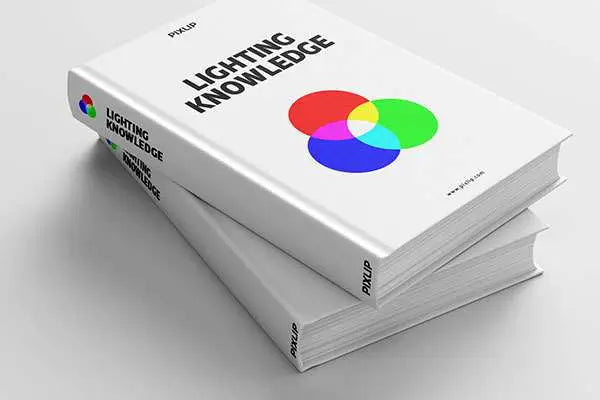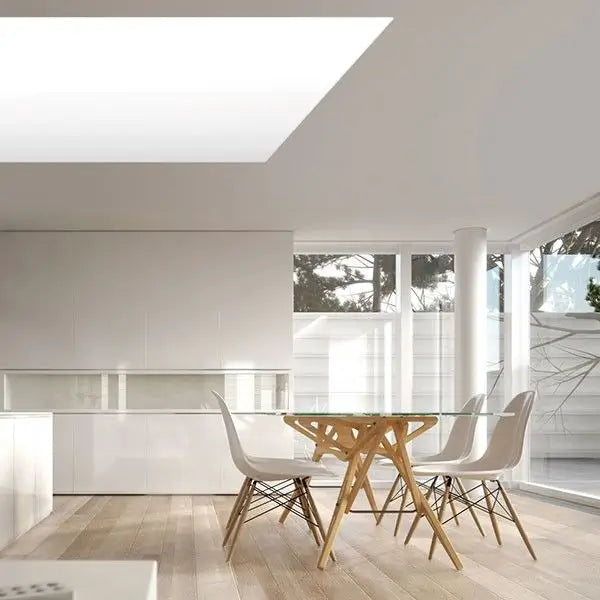
Quick assembly without tools.
Save time and personnel. Thanks to the modular plug-in system, assembly is intuitive and quick, without the need for tools or technicians.

When it comes to lighting, you quickly come across a multitude of technical terms. PIXLIP offers a brief overview of the most important terms, units, and dimensions in lighting technology.
Luminance
Luminance is the measure of the brightness impression emanating from an illuminated surface. It describes the ratio of luminous intensity to the size of the illuminated area: candela/m².
Special case: Similar to matte surfaces, translucent textiles do not reflect light, but transmit it. In this case, the luminance is calculated from the illuminance (candelas) and the transmittance. The transmittance describes the ratio of the transmitted and incident luminous flux.
Luminous flux
Luminous flux is measured in lumens (lm) and describes the total light output of a light source. Unlike the energy unit watt, luminous flux also takes into account the spectral sensitivity of the eye.
Luminous intensity
Luminous intensity refers to the luminous flux emitted by the light source in a specific direction. It is measured as lumens per solid angle: candela (cd). As the basic unit of lighting technology, all other lighting-related quantities are derived from it.
Light output
Luminous efficacy describes the amount of light (lumens) produced per watt of energy consumed. It therefore measures the cost-effectiveness and efficiency of the light source. The higher the luminous efficacy, the more energy- and cost-efficient the light source is.
Light duration
The average service life of a light source is defined as the point at which only 50% of its components are still functional. A long service life saves investment and maintenance costs. It is expressed in hours (h).
Illuminance
Illuminance (lux) describes the so-called luminous flux density over a surface and refers to the ratio between the luminous flux (lumens) and the size of the illuminated area in m² (lm / m²). It can be measured at any point in a room, but decreases with distance from the light source.
As a semiconductor diode, the LED (light-emitting diode) is an electroluminescent device. It converts electrical energy into light. As soon as an electrical current flows through the diode, it emits light.
Previously, this technology could only produce blue, green, yellow, and red light. LEDs were therefore primarily used as signal lights in switches or displays. It wasn't until the late 1990s that it became possible to generate white light using an additional fluorescent layer in the semiconductor crystal. Furthermore, it is now common practice to combine red, blue, and green LEDs to create the mixed color white. These RGB LEDs enable more than 16 million different light colors.
The development of high-performance LED lighting technologies is progressing at a pace similar to that of computer technology. Compared to conventional lighting solutions, LEDs already offer many decisive advantages in the areas of lighting design, cost-effectiveness, and sustainability. Architects and lighting planners have also recognized this trend. The new LED technology is being increasingly used in new buildings and renovations.
While the incandescent light bulb was pushed out of the market several years ago, the LED is currently striving for market leadership. Developers are therefore working particularly on "intelligent light management systems" that dynamically adapt to daylight conditions and people's biorhythmic needs. Further development is also focusing on more compact designs, improved light output, and more cost-effective production.
LEDs offer ideal conditions for a comprehensive and multifaceted lighting design:
Light quality: LEDs are available in various performance classes, which differ primarily in the desired brightness level. Thanks to their good color rendering index of Ra95 and a high luminous efficacy of up to 150 lumens/watt, they meet even the most demanding requirements. The point light source allows for precise light control. Optics can be used to further diffuse the light without glare. The wide range of colors also offers the possibility of creating atmospheric and effective lighting situations. With light colors ranging from 2500 K to 6000 K, a variety of white light can also be produced.
Lighting control: As an electronic component, the LEDs can be precisely controlled and continuously dimmed, making them easy to integrate into lighting management systems. For example, the lighting can be activated and dimmed via motion detectors. The instantaneous start-up of the LEDs and their rapid response to the control also enable fast and dynamic lighting scenarios.
LEDs offer a number of economic advantages over conventional light sources.
Long service life: LEDs are considered to be very resilient and robust. They can withstand not only rough shocks but also drastic temperature fluctuations. Early failures of the technology are rare exceptions. With service lives of over 50,000 hours, LEDs are significantly more durable than other light sources. After this time, they still emit about 70% of their original brightness on average and do not fail immediately. This virtually eliminates maintenance costs.
Energy efficiency: Compared to traditional incandescent bulbs, LEDs consume approximately 90 percent less energy. Operating costs can be significantly reduced due to their low power consumption. With a luminous efficacy of 110-160 lm/W, they achieve low power consumption.
Rising energy costs and scarce resources are causing more and more users to switch to energy-efficient solutions such as LED technology.
Light emission: The LED's light spectrum is only in the visible range. Therefore, there is no harmful UV or infrared radiation, meaning plastics, for example, are not damaged by the lighting and colors do not fade. Even animals and insects sensitive to nighttime light are protected by the lack of UV radiation.
Recycling: Unlike energy-saving lamps, LEDs do not contain toxic and harmful substances such as mercury and can therefore be disposed of in an environmentally friendly manner and without great effort.
Resource-saving: The low power consumption of LEDs ensures low CO2 emissions. The consumption of metals such as copper is also reduced.

Light & Mood
The human eye not only distinguishes between light and dark. Our perception is also influenced by the color of light: While warm white light is perceived as cozy, neutral white appears more cool and matter-of-fact.
perception
The eye is our most important sensory organ. We receive more than 80% of all information through our eyes: through light stimuli.
Ambient light is what enables our daily visual perception. This is especially evident in the dark or in insufficient lighting, when our vision is impaired and our orientation suffers. While we avoid darkness, we are attracted to light: an effect that particularly benefits advertising.
Light color
The so-called luminous color describes the intrinsic color of the light emitted by a light source. The luminous color is measured by the so-called color temperature in Kelvin (K). The "Planck radiator" is considered the benchmark for this color temperature.
This is an idealized, black body that absorbs light rather than reflecting it. When slowly heated, it undergoes a color spectrum from red to yellow to white and light blue. The higher the temperature, the whiter the color.
Color temperature
The color temperature of white light colors is divided into three main groups:
Warm white with color temperatures below 4000 K. This light color is perceived as cozy and relaxing and resembles the natural light during sunset.
Neutral white with color temperatures between 4000 and 5000 K. This color creates a rather cool, matter-of-fact mood and is therefore suitable for kitchens and bathrooms, for example.
Daylight white with color temperatures above 5000 K. This light color corresponds to daylight during midday and has a positive effect on our well-being. It promotes concentration and is ideal for workplace lighting.
Save time and personnel. Thanks to the modular plug-in system, assembly is intuitive and quick, without the need for tools or technicians.
Our backlit systems ensure eye-catching presentations at trade fairs, events, and POS. The interchangeable textile prints can be flexibly adapted at any time.
Our products are manufactured in Germany and undergo rigorous quality testing. You receive durable systems that meet the highest professional standards.